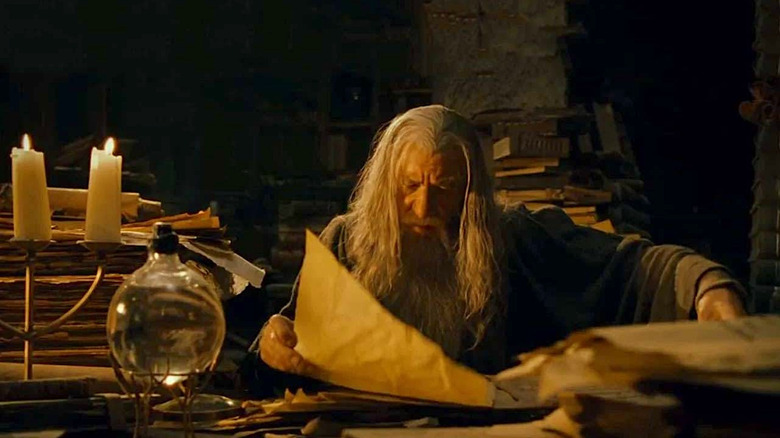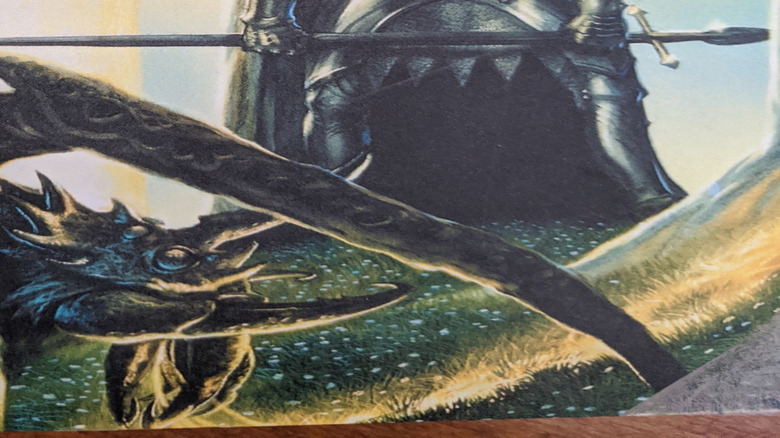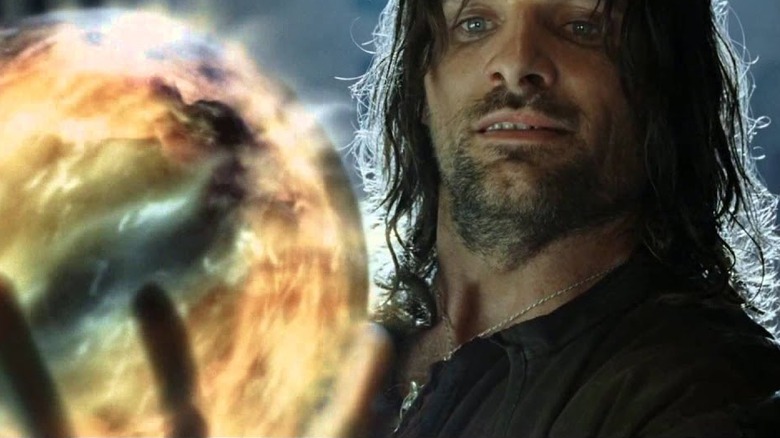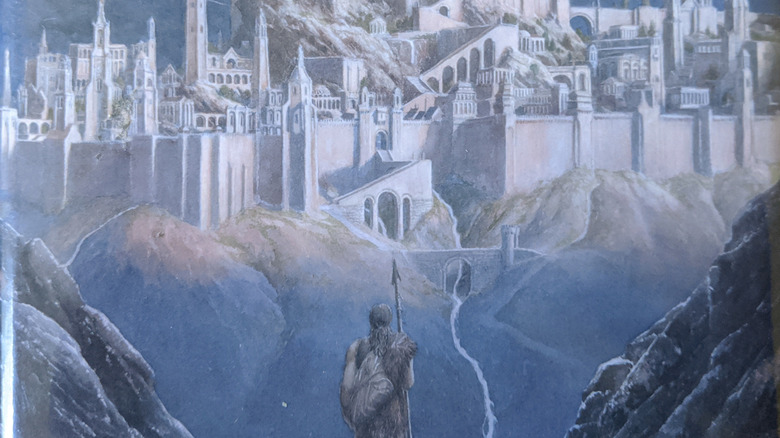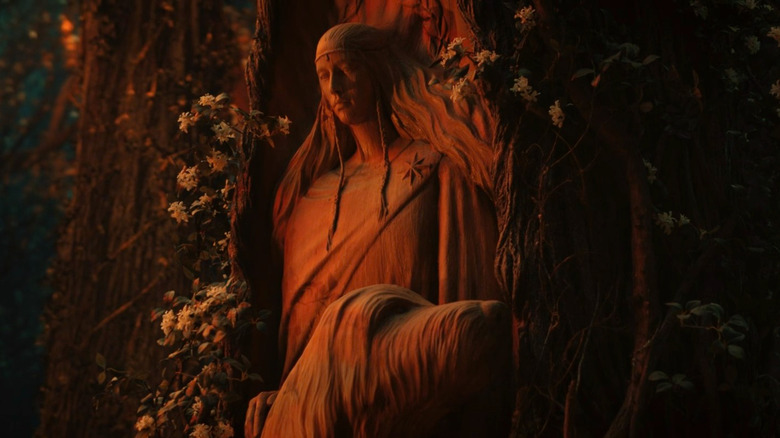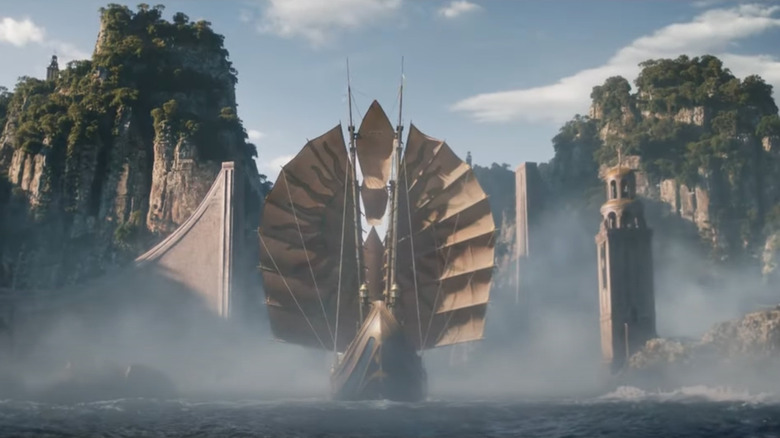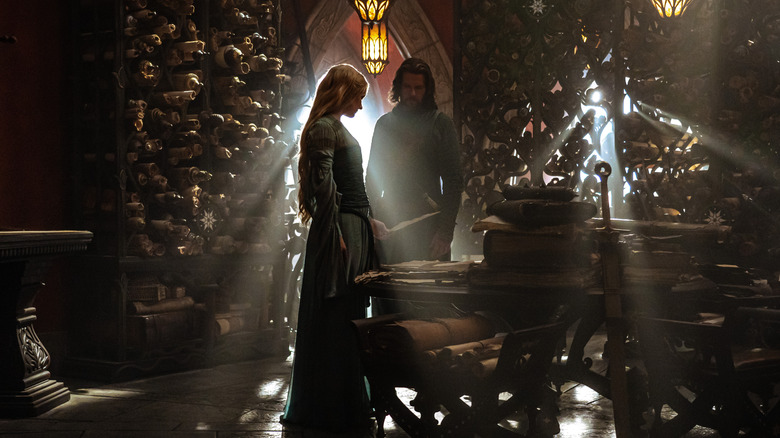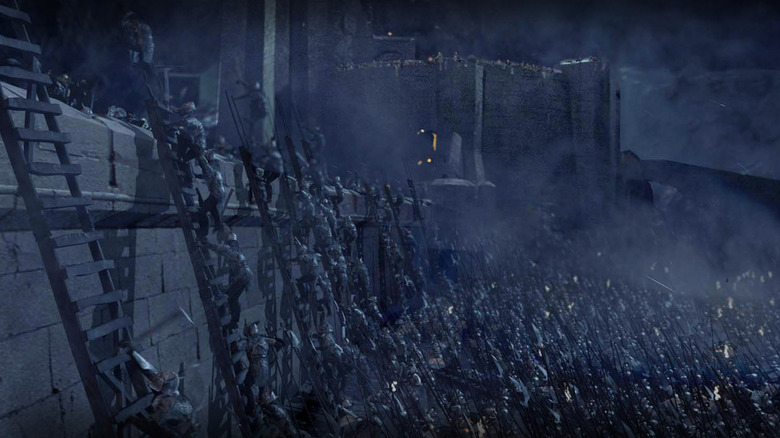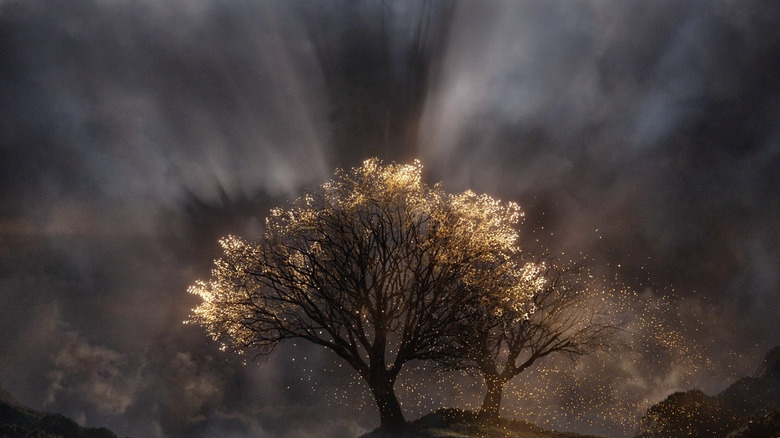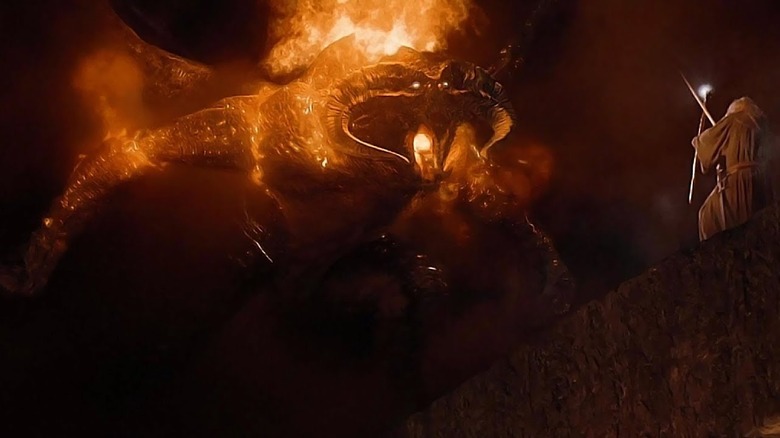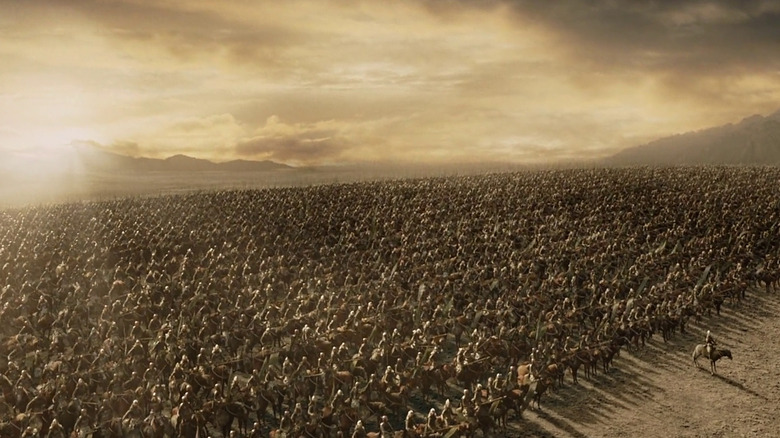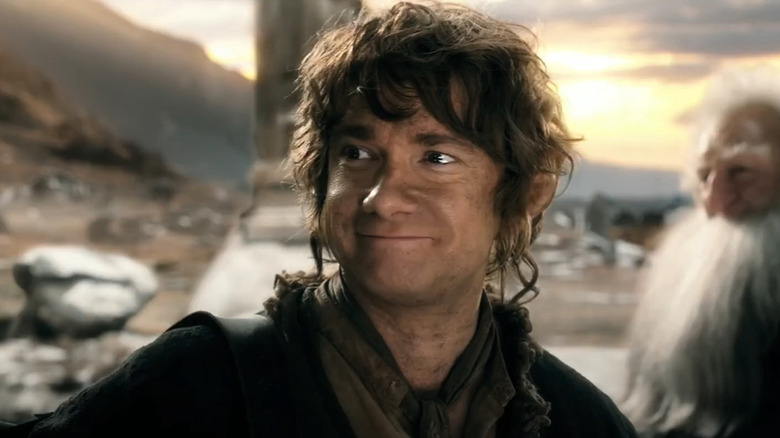Every Lord Of The Rings And Major Tolkien Middle-Earth Novel Ranked
Everyone loves "The Lord of the Rings." They make up a quarter of the top 12 movies of all time on IMDb's top 250 movie list, for goodness' sake. "The Hobbit" films are less grand but still entertaining, as is the "Rings of Power" and many of the older animated adaptations. While Looper has already gone on record with ranking the on-screen adaptations of Middle-earth, how does the source material stack up?
Let's rank the three books of "The Lord of the Rings," the Hobbit, and several of the other Middle-earth books by subjective quality. To avoid the list getting out of control, we're going to limit this to novels. There are several shorter entries, like "The Adventures of Tom Bombadil," "The Road Goes Ever On," and "Bilbo's Last Song" that we won't count. Comparing world-building novels with tiny slices of life is an apples-and-oranges situation, and this ranking is going to be difficult enough as it is.
For the diehards out there, we'll also draw a line against books like "The Nature of Middle-earth," since it's made up of scraps of original writing and tons of third-party input. Instead, we'll include more complete posthumous things that Christopher Tolkien, his son, helped publish. That includes "Unfinished Tales," "The Silmarillion," and some recent breakout stories. Okay, enough with the details. Let's dive into this thing. We do mean dive, too. This descending list starts with the toughest material to love, ending with the best.
11. The History of Middle-earth is a 12-volume slog
Yes, we're including "The History of Middle-earth" as a novel. We're also counting all 12 books as a single entry. For those who have never heard of this massive but fascinating collection, this is a pretty unique experience in fantasy. While not technically a novel, each book traces the history and evolution of Middle-earth (and its stories) as Tolkien shaped them. These are presented by Christopher Tolkien, who showcases his discoveries as he sorts through his father's notes after his death.
This encyclopedic collection is full of notes, commentaries, and different versions of the stories. It even includes the history of his "legendarium," the term for Tolkien's greater mythology of Middle-earth. There are original drafts of books like "The Silmarillion" (including some versions in poetic form), too. These give you an insider view of how that big Middle-earth meal was made.
The reason it comes in last place on this list is because this one is for the most faithful Tolkien fans, and that's about it. It isn't a light read. On the contrary, it comes across like an academic treatise. Christopher's writing is high-level, and many of Tolkien's texts are broken and incomplete, which means it's only a fun experience if you can keep up with incredible amounts of detail. And reading 12 lengthy, academically written books cover to cover? That's a slog for anyone, anywhere.
10. Unfinished Tales has confusing glimpses of greatness
"Unfinished Tales" is an interesting piece of fiction. Published after Tolkien's death, it contains several disconnected stories that he, well, never finished. It's in the title, right?
The reason it ranks so low on this list isn't because it's a slog, like the "History of Middle-earth" collection. It's more about the disjointed nature of the book itself. "Unfinished Tales" starts with partial versions of stories that we'll get later in this list, like the tales of Tuor and Húrin. Then it shifts to a focus on the Second Age (when "The Rings of Power" is set), but the longer narratives are replaced with focused accounts. Stories like the tale of Aldarion and Erendis, the Mariner's Wife, a history of Galadriel and Celeborn, and descriptions of the island of Númenor and its kings. After that, the third section presents Third Age stories, like the arrival of the Rohirrim in Rohan, how Thorin met Gandalf before "The Hobbit," and the hunt by the Black Riders for the One Ring. The final section is a collection of essays on things like the Wizards and the seeing stones known as the Palantíri.
See how scattered everything is? It gets worse. The history of Galadriel and Celeborn contains multiple versions, and it isn't clear which ones are correct or at least official. While less intimidating than the "History of Middle-earth series," this one is overwhelming in its details and disjointed nature. Save it for when you're really comfortable with the Middle-earth basics.
9. The Fall of Gondolin is great, but all over the place
Okay, now we're getting into the breakout stories from the early history of Middle-earth. There are a few novels like this, which will mostly live in the middle of this list (with one important exception). These books are cobbled together by Christopher Tolkien using his father's notes. Christopher worked hard to smooth out the unfinished sections, but in the case of "The Fall of Gondolin," it's difficult to get everything to flow smoothly and at a reasonable pace.
The book feels choppy at points, and the early part of the story is pretty slow. This is prime territory for a Tolkien-head to have a good time digging deep, looking for subtle connections to the more mainstream novels. But for the most part, it's a slow start.
The other thing holding this one back in our rankings is that it contains multiple iterations of the same story, kind of like a miniature version of "The History of Middle-earth." Don't get us wrong. The story of the Fall of Gondolin is compelling. It's actually the first "Middle-earth" story Tolkien wrote way back in 1917, while on sick leave during World War I. That's cool. But it isn't peak Middle-earth storytelling, and hearing one version of it after another, often with incomplete beginnings, middles, and endings, can be a bit lackluster if you're looking for a good story.
8. Beren and Lúthien is Tolkien's grand (but incongruous) epic
The tale of Beren and Lúthien is one of Tolkien's great romantic epics and a story every real fan should read at some point. Like the Fall of Gondolin, this one appears in other books like "The Silmarillion" and "The History of Middle-earth," but the standalone book is a treat — if you can keep up. This account synthesizes all of Tolkien's attempts to tell the tale into a somewhat single narrative that, more or less, has a beginning, middle, and end.
The issue, again, is that we're dealing with multiple versions and pieces of the Beren and Lúthien tale to make this work. For instance, this story is one of the first times we really get a good dose of Sauron. In the later versions that Tolkien wrote, Sauron is already the Dark Lord on a dark throne (even when he's still serving the original Dark Lord, Morgoth). In earlier versions, though — including in this book — he's replaced by a giant, villainous cat called Tevildo. Portions of the book are in prose and other sections are in poetry, too, which adds to the confusion. While we're starting to get a more focused narrative with this one, and the story is mint Tolkien, it's still too confusing to rank too high on the list.
7. The Fall of Númenor owns its convoluted tale
The book "The Fall of Númenor" came out more recently than most of the books on this list, and yet, it still suffers from the struggle of being a collection of disconnected pieces of a larger story. The difference this time? This book owns that fact. It doesn't try to present itself as a flowing narrative story (of a 3,500-years-long era, no less). Instead, it embraces a timeline approach.
Here's the opening sentence from the novel's "About This Book" intro: "'The Fall of Númenor' seeks to present, in a single volume, selections from J.R.R. Tolkien's posthumously published writings about the Second Age of Middle-earth." It adds shortly afterward that the book aims to do this with "as few editorial interventions as possible," too.
In other words, "The Fall of Númenor" takes many of the separate mentions, stories, descriptions, and summaries about Númenor and its age and puts them in a chronological presentation. This helps the book create a sense of progression, as if a story is playing out. It feels like a fantastical history book at points, but the voice is mostly Tolkien's own, and it's a great way to experience the Second Age of his world (especially with currently airing shows like "The Rings of Power" taking place during that time).
6. The Silmarillion dominates old Middle-earth storytelling
Alright, we've come to it at last. The great novel of Middle-earth's Elder Days. What do we mean by that? This is a book primarily focused on events that happen thousands and even tens of thousands of years before "The Hobbit" and "The Lord of the Rings." It's like reading a book about the Egyptian pharaohs, Babylonian kings, and Assyrian conquerors. Yes, it connects to the present, but we're talking about truly ancient history.
"The Silmarillion" starts with the creation of Middle-earth. It traces the early millennia of its history, the arrival of the Elves and Men, the creation of Dwarves, Orcs, Ents, and Eagles. Then, it launches into an epic retelling of how all of these groups resist two different Dark Lords — first Morgoth, then Sauron — throughout Middle-earth history. We get truncated versions of tales like The Fall of Gondolin and Beren and Lúthien. Toward the end of the book, there is a lengthy story about the Fall of Númenor, and it ends with a fast-paced romp through the Third Age, ending with a recap of "The Lord of the Rings."
Make no mistake. "The Silmarillion" is overwhelming. It's also an incomplete picture that, once again, Christopher Tolkien forged, Frankenstein-style, from his father's unfinished writings. However, it is the definitive historical account of Middle-earth. It doesn't complicate things with multiple versions of the story, or shift to poetry for long sections. Instead, it provides a relatively smooth path throughout Middle-earth's history, zooming in for individual stories at points, but maintaining a larger arc throughout. Is it hard to follow at points? Yes. But it's a top read for anyone interested in Middle-earth.
5. The Two Towers is great, but suffers from middle-story syndrome
We've officially reached our first "Lord of the Rings" novel. "The Two Towers" is a classic fantasy experience. Before we explain why it ranks the lowest of the trilogy, though, let's clarify a few things. Peter Jackson's movies don't follow the trilogy verbatim. "The Fellowship of the Ring" book and movie end at the same point, but "The Two Towers" book actually goes through the death of Saruman and Frodo and Sam's confrontation with Shelob. The former is cut from the films entirely (and added back in the extended version), and the latter is set during "The Return of the King." So, there's actually a lot going on in the written version besides the Battle of Helm's Deep.
The reason it ranks lower than the other two books (and a couple of other Tolkien books, even) is due to the unfair disadvantage of being the middle part of a trilogy. We've seen good arguments for why this one is actually the best book, but at the end of the day, it's hard to present a story without a beginning or ending that's still compelling. The second act of a story is where a lot of critical development takes place, and "The Two Towers" is essential to the larger "Lord of the Rings" experience, but it still feels incomplete. You can't get around it. That said, this is still top-shelf Tolkien, and it naturally falls high on the list.
4. The Children of Húrin is the ultimate Tolkien tragedy
Yes, folks. There is another book on this list that ranks up there with the "Lord of the Rings" and "The Hobbit," and for quite different reasons, too. Tolkien's famous trilogy is full of hope in the face of despair. "The Hobbit" is light-hearted and even silly at times. But "The Children of Húrin"? This is the definitive depressing Tolkien experience to rule them all. It's the darkest hour for Middle-earth, and Tolkien shows just how grim his writing can get when he's in the mood.
"The Children of Húrin" follows the story of the human hero Húrin after Morgoth captures him in battle, putting a curse on him and his family. The bulk of the story follows his son, Túrin, as he plays the role of the tragic hero. Terrifying tragedy plagues Túrin as he goes from one awful event to the next. From causing the downfall of kingdoms he loves to accidentally killing his best friend, and even unwittingly marrying his own sister, this is about as messed up as Middle-earth can get.
It's ranked so highly because it's also some of Tolkien's best work. The story grips you as you watch Húrin and his family try to overcome their fate, fighting to resist Morgoth as he singles each of them out for a unique level of torture and harassment. Oh, and did we mention that it features a duel between Túrin and the father of all dragons? Yeah, this one is a page-turner.
3. The Fellowship of the Ring is a classic gateway to Tolkien
If you ask someone if they've read Tolkien, chances are that if they have, they've read at least part of "The Fellowship of the Ring." This is one of the classic entry points for the Tolkien experience. "The Hobbit" is the other one — more on that in a minute.
"The Fellowship of the Ring" starts with a gentle but immersive introduction to Middle-earth via a deep dive into Shire culture. From Bilbo's birthday party to Frodo and Gandalf's "shadow of the past" conversation, it helps readers adjust to the hefty Middle-earth experience before they're swept into the larger "Lord of the Rings" saga. Before they know it, they're confronting Black Riders, hearing the history of Middle-earth summarized by Elrond, confronting cursed mountain tops, battling balrogs, and meeting Galadriel in her haven of Lothlórien.
The book is the perfect introduction to the massive world Tolkien built. It touches on countless facts and stories from early Middle-earth history without too much narrow focus. The narrative pace is also better than most of the books on this list, since this one, like "The Hobbit" and the other two books in the trilogy, is presented as an actual story-driven novel. Add it all up, and "The Fellowship of the Ring" is a top Tolkien read — but it isn't the best one. Not even of the "Lord of the Rings" trilogy.
2. The Return of the King is the best Lord of the Rings book
There's nothing like when a book sticks the landing. When it can do that for three books at once, it's even better. "The Return of the King" contains some of Tolkien's best writing. The author takes the stakes that he's built up over two novels and plays everything out in compelling detail.
The charge of the Rohirrim on the Pelennor Fields is as awesome (if not more so) than the film version. Frodo and Sam's trip through Mordor is even better here, if only because you actually know what's going on inside their heads. The archaic yet epic writing for events like the last stand of Aragorn and the Captains of the West in front of the Black Gates of Mordor sends a chill down your spine. To cap it off, there's the entire finale of the Scouring of the Shire. In the Foreword to the Second Edition of the trilogy, Tolkien himself called this Shire-based showdown "an essential part of the plot, foreseen from the outset." Peter Jackson nixed it in his already long adaptation, and we understand his choice. It's still a fantastic read.
Whether you like epic last stands, romantic tales, overcoming overwhelming evil, happily ever afters, or any other element of high fantasy, this book will scratch that itch. It's the ultimate Tolkien novel — with one surprising exception.
1. The Hobbit is the best Tolkien experience
If you've only ever watched the "Lord of the Rings" movies and the "Hobbit" trilogy, you're probably wondering what the heck is going on here. How is Bilbo's overlong, over-digitized story about stealing gold from a dragon better than the world-altering epic of Frodo's quest and Aragorn's rise to power? Here's the thing: The "Lord of the Rings" trilogy as a whole is a top Tolkien experience. But if you're taking books individually, it's hard to say that one of those three books is categorically better than the others.
If you think about it, "The Hobbit" is actually the only time you can experience a complete Tolkien story, cover to cover, in one volume. Topically, it's also much lighter than "The Lord of the Rings." Tolkien wrote it when his kids were younger, and he narrates directly to the reader a lot. He also brings in random fantastical influences, like giants and talking purses.
"The Hobbit" is a book that has something for everyone. It has fun moments for the kids as well as rich story beats for the adults. It starts out almost flippantly light and ends with epic alliances and all-out wars. It sets the stage for the "Lord of the Rings" story that follows — all while introducing one of Tolkien's trademark fantasy inventions: the folk we know and love as the Hobbits. It's hard to pick favorites here. But if you have to choose a single book that stands above the rest, "The Hobbit" is our top choice.
